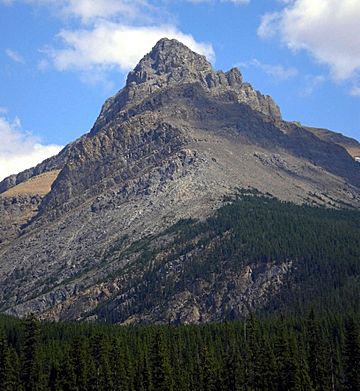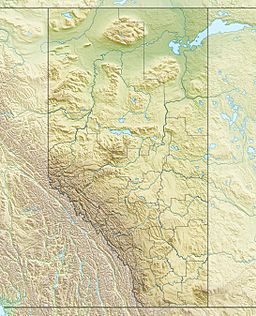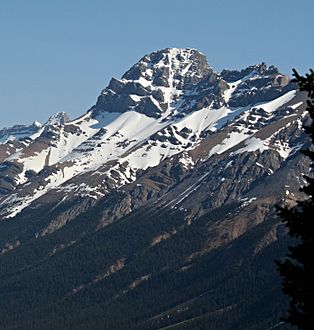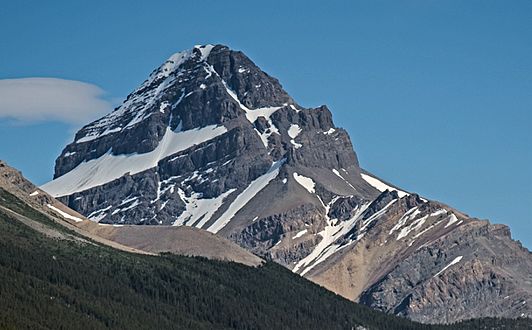Mount Weed facts for kids
Quick facts for kids Mount Weed |
|
|---|---|

Mount Weed seen from Icefields Parkway
|
|
| Highest point | |
| Elevation | 3,080 m (10,100 ft) |
| Prominence | 383 m (1,257 ft) |
| Parent peak | Observation Peak (3174 m) |
| Listing | Mountains of Alberta |
| Geography | |
| Location | Alberta, Canada |
| Parent range | Murchison Group Canadian Rockies |
| Topo map | NTS 82N/15 |
| Geology | |
| Age of rock | Cambrian |
| Type of rock | Sedimentary |
| Climbing | |
| First ascent | 1936 by L. Gest, Mr. and Mrs. H. Kingman, H.S. Kingman Jr., W. Kingman, C.Hasler Jr. |
| Easiest route | Scramble |
Mount Weed is a tall mountain, about 3,080 meters (10,105 feet) high. It is located in the Mistaya River valley within Banff National Park in Alberta, Canada. This mountain is part of the amazing Canadian Rockies.
Mount Weed stands where Silverhorn Creek meets the Mistaya River. It's about 3.5 kilometers southwest of Mount Noyes and 4.5 kilometers east of Mistaya Lake. You can easily spot Mount Weed from the Icefields Parkway, a famous scenic road. Its closest higher peak is Mount Patterson, which is about 5.82 kilometers southwest. Both Mount Weed and Mount Patterson are important landmarks in the Mistaya River valley.
Contents
Discovering Mount Weed's Name
Mount Weed got its name in 1902 from J. Norman Collie, a well-known explorer. He named it after George Marsten Weed (1864-1948). George Weed was a climber from the Appalachian Mountain Club. He explored the Rockies and was the first to climb several peaks. J. Norman Collie and George Weed even climbed Mount Forbes together in 1902! The name "Mount Weed" became official in 1928.
First Climbers to Reach the Top
The first time anyone successfully climbed Mount Weed was in 1936. A group of climbers made the ascent. This group included L. Gest, Mr. and Mrs. H. Kingman, H.S. Kingman Jr., and W. Kingman. They had a guide named Christian Hasler Jr. who helped them reach the summit.
Understanding Mount Weed's Geology
Like other mountains in Banff Park, Mount Weed is made of sedimentary rock. This type of rock formed over millions of years from layers of sand, mud, and other materials. These layers were laid down in shallow seas during the Precambrian to Jurassic periods.
Later, during a time called the Laramide orogeny, these sedimentary rocks were pushed up. This powerful geological event caused the rocks to fold and break, forming the mountains we see today. The older rocks were pushed over the top of younger rocks, creating the unique structure of the Canadian Rockies.
Mount Weed's Climate and Weather
Mount Weed is located in a subarctic climate zone. This means it has very cold and snowy winters. The summers are usually mild. Temperatures can drop below -20 °C ( -4 °F) in winter. With the wind chill, it can feel even colder, sometimes below -30 °C (-22 °F).
The weather patterns here are based on the Köppen climate classification system. Snow and rain that fall on Mount Weed eventually drain into the Mistaya River. This river is a tributary, meaning it flows into, the North Saskatchewan River.
Gallery





